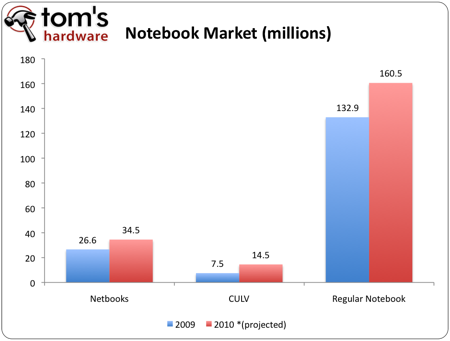Behind the Tech: Sandy Bridge Recall, An Insider's Story
What was the exact timeline of Intel's Cougar Point recall? How early did the company know about its problem? How does this affect the competitive AMD and Intel landscape? Continue reading to discover our answers to these lingering questions.
The New Battlefield
One week after Intel’s recall notice, on Valentine's Day, AMD sent out some snarky cards teasing Intel about its current situation. It complemented the cards with a lot of chocolate. That chocolate was very tasty. AMD even went so far as to launch a new marketing campaign titled “Ready, Willing, and Stable” as a reminder of Intel’s stop-shipment action. Leslie Sobon, AMD’s VP of Product and Platform Marketing, said in an interview with Dow Jones Newswires that "We have some customers and retailers who have come to us specifically as a result of Intel's chip problem. Some retailers have had to take things off their shelves, so they call us to ask what they could get from our OEMs that are similar. And OEMs are asking us for product as well."
According to our contacts at Best Buy and to those in the motherboard business, this probably isn't as optimistic for AMD (or its investors) as it might seem. Motherboard makers did not increase AMD motherboard production to compensate for the loss of Sandy Bridge-based sales. Similarly, stores didn't see any substitution effect in the buying habits of consumers. According to sales personnel, customers are still excited about Sandy Bridge, and the recall doesn't seem to have tempered interest in the product.
Unfortunately, even the best marketing attempts won’t make a difference in AMD’s market share right now. The stark reality is that there is no equivalent to compete with Sandy Bridge microprocessors. Full shipments of B3 chipset-based motherboards have already begun. Meanwhile, we expect to see Llano samples at Computex, but this still gives Sandy Bridge a three-month head start.
Until the launch of Llano (AMD says the first Llano parts are already shipping, but what does that mean to us if they're in the hands of OEMs and not enthusiasts?), AMD gets to focus on its Zacate and Ontario APUs, which have already seen marginal success. The price of notebooks based on these solutions is still rather high, though. And "doorbuster" models are often revenue losers. However, the high volume of budget notebooks sold is hard to ignore. AMD's Brazos platform allows notebooks to be sold for $400 without the negative stigma of Atom. But overall, performance just isn’t that much improved.
Microprocessor shipments are expected to grow about 10.1% this year, compared to the 17.1% growth in 2010. Large- and mid-sized corporations are expected to drive most of this growth with notebook sales for their employees. Meanwhile, consumer purchases are expected to remain weak because of economic concerns and competition from tablets.
There is some good news. Our motherboard contacts are very impressed by their preliminary look at Llano (CeBIT 2011: AMD Demos Llano Behind Closed Doors). As AMD tries to do battle on Intel's turf, it's battling the effects of time to the same extent it's throwing down with its major competitor. Competitive solutions only stay competitive when they are delivered on time, and most of the Llano news we're used to seeing starts with something about a delay.
As one motherboard VP stated, “AMD needs to deliver soon. They can’t keep spending cash the way they have and expect to remain profitable quarter after quarter.” It’s true that AMD is spending a lot on its Fusion initiative, which is why there is a great deal riding on Llano. Regardless of price, AMD can only go so far by selling processors that match the performance of Intel's previous generation.
Get Tom's Hardware's best news and in-depth reviews, straight to your inbox.
-
acku Reply9512301 said:Lol, that neighborhood watch picture still creeps me out to this day.
Well that's why you shouldn't talk to strangers. :) -
dogman_1234 So Intel noticed the problem before hand and did nothing until it became apparent? I am not one to criticize Intel, but if any error is noticed, i would warn of it immediately.Reply -
ferelden Sandybridge performance is just too beastly for this to affect it long term, most people who have just come into the cpu market to upgrade didn't even realize there was a recall in the past and just got a b3 p67 and i5-2500k without any hesitationReply -
Stardude82 Knowing the problem, I'd totally buy a B2 board at a serious discount. Most PC's only have 2 drives anyway and SATA add-on cards are cheap.Reply -
f-14 i didn't see any problem for sales, people just bought core i-7 9XX'sReply
AMD could crow all they wanted, they didn't have a new product going to the shelf capable of beating the previous i-series. now had AMD released llano during this, they would have made a pre-emeptive death knell strike against sandybridge, but they didn't so it didn't matter what happened until AMD does. -
f-14 oh and also the problem could have been more easily rectified by intel giving out coupons for sata3 devices priced to match sata2 devices and pull it off as a promo that would have sold them millions more in profits.Reply
as for the people who already bought a 'free' sata 2 device to sata3 replacement device coupon would have been cheaper also.
Intel just blew a huge marketing opprotunity to grind AMD under the imperial capitalist yankee boot.
IMO -
joytech22 All I can say after reading this is that Intel did a great job with this issue.Reply
But it somehow still brings me back to how AMD is still spending money on a product we haven't even seen benchmarks about yet.
Somebody who uses an OEM machine somewhere around the world MUST have released a benchmark of Llano or BD at some point in time. -
rolli59 It is just business! I wonder if the speculations on the time line is true but most definitely the OEM's had discovered problems well before release.Reply -
emergancy exit or people are just brand loyal to the point of insanity. and intel is cashing in and and keeping their prices high.Reply

